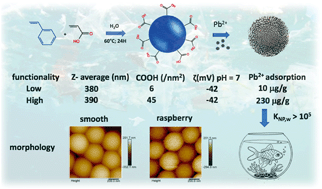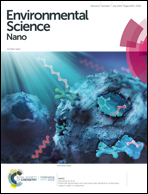Soap- and metal-free polystyrene latex particles as a nanoplastic model†
Abstract
The ability of nanoplastics (NPTs) to bioaccumulate and cotransport pollutants in the whole organism is one of the most dangerous aspects of this form of plastic debris, defining a new class of emerging pollutants that is still largely unknown. In this context, it is essential to have accurate and representative models of nanoplastics to better understand their toxic effects. Models reported in the literature and commercial standards are far from mimicking the relevant properties for transporting pollutants, such as the size, shape, composition, purity, functionalization and surface morphology of nanoplastics sampled in the environment. Due to the lack of such nanoparticle models, we proposed an alternative nanoplastic model challenging three of the key properties affecting interactions with trace metals: purity, morphology and surface functionalization. NPTs with different surface functionalities (6–7 and 43–45 carboxylic groups per nm2), with smooth or raspberry-like surface morphologies, and that were monodisperse in size (PDI < 0.05) were synthesized using soap free emulsion polymerization. NPTs were stable over time as a function of the salinity and pH (potential zeta < −33 mV, pH = 4–6, salinities < 500 mM). These nanoplastics were free of additives such as surfactants and stabilizers, and their metal content was measured to be less than 100 ppt (Cr, Fe, Ni, Co, Zn, As, Se, Ag, Cd, Au, Gg, Ce and Pb). Their metal absorption capacity was evaluated on lead(II) using AF4-ICPMS and electrochemistry and was characterized by a partition coefficient of lead between that of NPT and water, of approximately 105.



 Please wait while we load your content...
Please wait while we load your content...